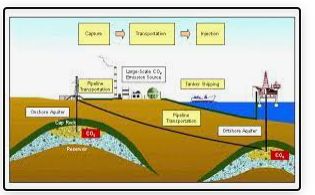Geophysics provides technology with which we can "look" into the subsurface. It is a key enabler of many activities in the search for hydrocarbons, minerals, fresh water, and geothermal energy. Of the many existing geophysical methods, three are important for monitoring CO2. These are Seismic and Electromagnetic and Gravity methods. CO2 injection can be done for sequestration as well as enhanced oil recovery
In the first method, high resolution seismic up to 250 Hz can be acquired with short offsets. For deeper layers, long offset seismic is collected. Long offsets are needed for Refraction Static corrections and in case Full Waveform Inversion is applied for obtaining the diving waves. For CO2 sequestration, the presence of fractures and their orientation, being natural or induced is a significant hazard that can be determined from seismic.
The second important geophysical method is electrical and electro-magnetic methods. Electrical or Direct Current surveys use grounded electrodes for source and receivers. They measure the potential difference using increasing receiver electrode spacing. Changes in measured potentials contain information on the resistivities of the subsurface, which can be related to changing pore fluids, like CO2 replacing brine. Electro-Magnetic can use either grounded or inductive sources (aerial surveys), but also natural sources as used in Magneto-Telluric surveys. These Electro-Magnetic sources can be a harmonic source (using a single frequency) and the measurement of the magnitude and phase delay, or real and imaginary responses are used. The other Electro-Magnetic source option is a step-off function. The subsurface information is then contained in the amplitude decay after shut-off.
The third approach is using Gravity measurements. These could be changes in the vertical gravity component Gz or the Full-Tensor-Gravity (FTG), which measures gradients in the gravity field. With the increasing accuracy of modern instruments, changes in the CO2-brine interface have been measured in oil (Prudhoe Bay, Schrader-Bluff and Troll field) and gas-storage (Izaute) fields
